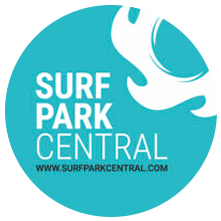
At Surf Snowdonia, a roughly 7-million-gallon man-made wave pool in Wales, the intermediate wave is ideal for longboarding. Is this the future of surfing? Photo: Tom Van Schelven for The Wall Street Journal
Artificial Wave Pools: A Landlocked Surfer’s Solution?
Wavegarden, a Spanish engineering company, is making waves that could land the sport in the Tokyo Olympic Games. Could this be the future of surfing?
Published by Stan Parish in The Wall Street Journal
December 1, 2015
IN SEPTEMBER 2015, A SURF CONTEST CALLED RED BULL UNLEASHED drew 24 pro surfers and 2,000 spectators to the village of Dolgarrog in North Wales, more than quadrupling the population. Wales is not short on coastline, but the location was unusual. Dolgarrog is landlocked, 10 miles from the sea.
The contest was held at Surf Snowdonia, a roughly 7-million-gallon man-made wave pool that had opened the month before. Albee Layer, a Hawaiian known for his big-wave prowess and progressive style, took home the trophy after two days of heats in head-high artificial surf. In a post-event interview, Layer was asked if the wave pool had made him a believer. “Yeah,” he said, “I think it’s gonna change things.”
The technology used at Surf Snowdonia was born somewhere outside San Sebastian, Spain. In 2013, a Spanish company called Wavegarden lit up the Internet with a video of perfect, peeling waist-high surf in what looked like a ditch lined with garbage bags. An ensemble cast of all-star surfers tore the waves apart with powerful turns and aerial maneuvers, grinning like idiots. The ditch, in an undisclosed location, was Wavegarden’s test facility—over a decade in the making. Today, the company is posed to go global with their patented “wave foil,” a plow-like device that runs back and forth on an underwater track, creating identical, point-break-style waves on both sides of an elevated pier. The next pool slated to use the technology is NLand Surf Park in Austin, Texas, backed by Doug Coors of the brewing dynasty, and scheduled to open in 2016. According to Fernando Odriozola, Wavegarden’s business development director, the company has financial commitments for 24 projects in Australia, Africa, Asia, North America, Europe and the Middle East. The 6-foot surf at Surf Snowdonia is not the upper limit. “If there’s an investor willing to pay for bigger waves,” Odriozola said, “we can deliver.”

Surf Snowdonia’s pastoral setting. Photo: Tom Van Schelven for The Wall Street Journal
Wavegarden’s latest delivery has elicited loud laments about pay-to-play commercialization (Surf Snowdonia costs between $30 and $45 an hour, which gets you about 13 waves). And beginner-friendly wave pools have always drawn a get-off-my-lawn response from surfers seeking a moratorium on new blood and overcrowding. But the success of Surf Snowdonia means waves are no longer a finite resource, and surfing is no longer a zero-sum game. More importantly, it marks the arrival of wave-riding—for better or for worse—as a spectator sport.
The writer William Finnegan saw things differently in 1992. “Surfing is not a spectator sport,” he wrote in “Playing Doc’s Games,” a New Yorker series widely considered the best writing on the sport. In Part II, Finnegan describes his girlfriend’s bird’s-eye view of a surf break as a transformational moment in her appreciation of waves: “Suddenly, she could see that they were in fact pyramids, with steep sides, thickness, broad, sloping backs, and an incredibly complex three-dimensional construction, which changed, collapsing and rising and collapsing, very quickly. It was nearly enough, she said, to make watching surfing interesting.”

Head coach Jo Dennison eyes the lip before a turn. Photo: Tom Van Schelven for The Wall Street Journal
Watching surfing is certainly interesting to some. Last year, an average of 6.2 million people tuned in live for the Billabong Pipe Masters, a surf contest on the North Shore of Oahu. Surf videos, including bird’s-eye drone clips, have racked up billions of views online. In September, Japanese organizers, who are currently in talks with Wavegarden, submitted five new sports to the International Olympic Committee for inclusion in the Tokyo 2020 games: baseball/softball, karate, sport climbing, skateboarding and surfing. The latter is considered a shoo-in for the biggest athletic spectator event in the world.
What surfing hasn’t been is a live spectator sport. Unless you were willing to track swell activity around the globe and fly to Tahiti on short notice, there was no sure-fire way to see the world’s best surfers in good waves and in the flesh. Wave pools will change that. And the elevated pier at Surf Snowdonia offers the transformational vantage point William Finnegan described, only much closer to the action—spectators can feel the spray that flies off the back of a wave when a surfer hacks into it with their fins.

The park’s unsung, excellent intermediate wave is ideal for longboarding, with a novice-friendly whitewater takeoff and smooth ride. Photo: Tom Van Schelven for The Wall Street Journal
Of course, nothing can replace the ocean. And a wave pool’s artificiality takes some getting used to. “Stay closer to the fence,” is the last thing you expect to hear when you’re on a surfboard in a wetsuit, waiting for a wave, but those are my instructions from Jo Dennison, four-time Welsh surfing champion and Surf Snowdonia’s head coach. The fence is a long stretch of chicken wire underneath the pier that splits the peat-colored lagoon in half, and it’s the only thing between surfers and the fast-moving wave foil. There’s a crescendo of engine noise as the foil knifes through the water behind me, its top edge looking disconcertingly like a fin. The lack of salt, the mechanical din, the chicken wire—none of it prepares you for the 6-foot wall of water that looks and feels like something the Atlantic might serve up on a (rare) above-average day. I surfed the ocean every weekend for six weeks before I flew to Wales, but caught more respectable waves in one day at a wave pool (27) than I did in the entire month of August.
Before I paddled out at Surf Snowdonia, I watched two elderly women enter the indoor bar area and take a table that looked out on the pool. Another elderly couple followed, and then another, until local senior citizens almost outnumbered the surfers and the staff. Some ordered tea, but most just sat there, mesmerized by the dynamic rhythm of Jo Dennison’s powerful carves. “Oh, we get visitors from 9 to 90,” said Steve Davies, the park’s managing director, when I asked if this was normal. Retired Welsh villagers is not a demographic that the World Surf League is actively chasing, but here they were, completely hooked. I spoke to Jim and Sandra Thorpe, a white-haired couple from a few miles down the road. What did they think?
“It’s brilliant,” Sandra said, meeting my eyes and then looking over my shoulder as another wave peeled past.
Read the full story at WSJ.com for Stan Parish’s take on Surf Snowdonia, Wavegarden and the Future of Surfing
























You must be logged in to post a comment Login